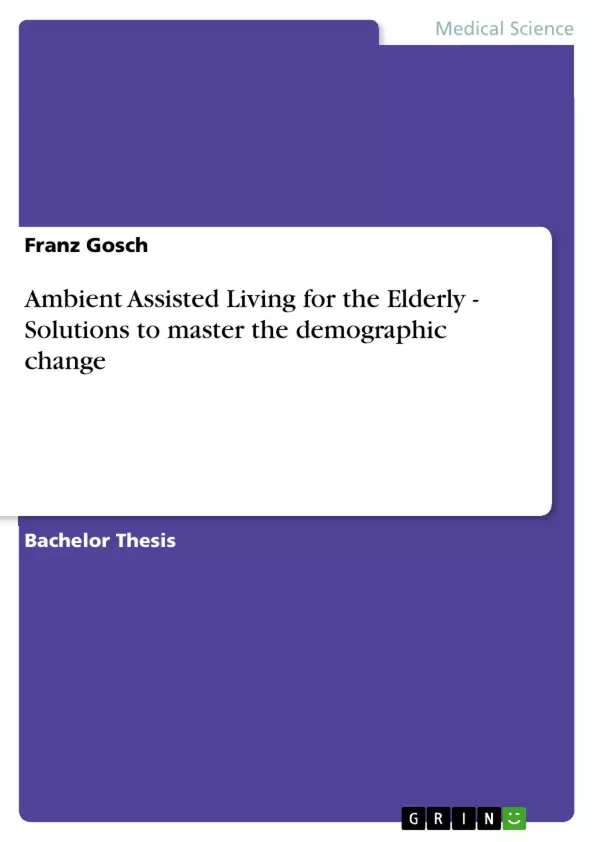According to Eurostat statistics, the proportion of elderly people in Europe is increasing immensely. While fewer children are born, death is prolonged and people become older. This scenario of demographic changes in the western world raises questions to which answers are rather unclear, as for instance: Who will care for the elderly and how will this look like?
The answer to this question may be ambient assisted living (AAL), a branch of information and communication technologies (ICT) aiming at keeping elderly persons as independent as possible in their familiar surroundings in order to postpone hospitalization.
The EU plays a major role in developing AAL solutions and enhancing research in the area of ICT, as depicted by the 6th framework programme 2002-2006 or the EU’s e-inclusion policy featuring the Digital Agenda 2010, just to name examples (European Commission, 2002; 2007; 2010). However, it remains questionable which challenges AAL – seen as an innovation – faces.
The aim of the research in this thesis is to present the field of AAL with relation to home care. Furthermore, the work of the European Union (EU) in the field of AAL is presented, as the EU is a major key player in enhancing research on AAL solutions that help meeting the demands of the future. Moreover, a categorization scheme of AAL solutions is developed through research evidence. Eventually, knowledge and evidence from the research conducted is used to give recommendations for the future concerning the diffusion of AAL and research directions.
In order to answer the research question and the objectives, the thesis first presents the theoretical framework that is used for the research, i.e. the Diffusion of Innovations Theory. Thereafter, a chapter on the methodology follows, which is characterized by a dual nature, as it involves a document analysis and a systematic literature review. Subsequently, the paper presents the results of the research, divided into EU actions and initiatives and ambient assisted living at a glance with categorizations of its types and related challenges. Finally, the last chapter discusses the findings, answers the research question and gives recommendations on how the diffusion of AAL can be enhanced.
Inhaltsverzeichnis (Table of Contents)
- Introduction
- Background
- Central research question and objectives
- Methodological approach and structure of the thesis
- Theoretical framework
- Diffusion of Innovations theory
- Application of the Diffusion of Innovations theory
- Methodology
- Nature of the research
- Steps in the research procedure
- Review of EU policies, projects, and initiatives
- Review of studies on AAL
- Reliability and validity
- Results
- EU actions towards AAL
- Ambient Assisted Living at a glance
- Main Results
- Discussion
- Discussion of AAL on grounds of the Diffusion of Innovations theory
- Discussion of methods
- Answer to the research question
- Recommendations and conclusion
Zielsetzung und Themenschwerpunkte (Objectives and Key Themes)
This thesis investigates the topic of Ambient Assisted Living (AAL) as a solution to the challenges posed by the demographic changes in Europe. It aims to analyze the current state of AAL, its potential for supporting independent living for the elderly, and its implementation within the context of the Diffusion of Innovations theory. The key themes explored in this thesis include:- The impact of demographic changes on the care needs of the elderly population.
- The potential of AAL to support independent living and enhance the quality of life for elderly individuals.
- The implementation of AAL within the framework of the Diffusion of Innovations theory.
- The role of EU policies, projects, and initiatives in promoting AAL.
- The challenges and opportunities associated with the development and adoption of AAL solutions.
Zusammenfassung der Kapitel (Chapter Summaries)
- Chapter 1: Introduction: This chapter provides a background on the demographic changes occurring in Europe, highlighting the increasing proportion of elderly citizens. It also introduces the central research question and objectives of the thesis, as well as the methodological approach and structure of the work.
- Chapter 2: Theoretical framework: This chapter presents the Diffusion of Innovations theory and its application to the study of AAL. The theory is used as a lens to understand the factors influencing the adoption and diffusion of AAL solutions.
- Chapter 3: Methodology: This chapter outlines the research methodology used in the thesis, including the nature of the research, steps in the research procedure, and a review of EU policies, projects, initiatives, and studies on AAL. It also addresses the reliability and validity of the research findings.
- Chapter 4: Results: This chapter presents the findings of the research, including an analysis of EU actions towards AAL, a general overview of Ambient Assisted Living, and key results related to the topic.
- Chapter 5: Discussion: This chapter discusses the findings of the research in relation to the Diffusion of Innovations theory, the methodological approach, and the research question. It also presents recommendations and conclusions based on the analysis.
Schlüsselwörter (Keywords)
The main keywords and focus topics of this thesis include Ambient Assisted Living (AAL), demographic changes, elderly care, Diffusion of Innovations theory, European Union policies, ICT-enabled solutions, and independent living. These terms encapsulate the primary themes and research areas explored in the work, highlighting the intersection of technological advancements, societal trends, and public health concerns.- Quote paper
- Franz Gosch (Author), 2012, Ambient Assisted Living for the Elderly - Solutions to master the demographic change, Munich, GRIN Verlag, https://www.grin.com/document/213337



